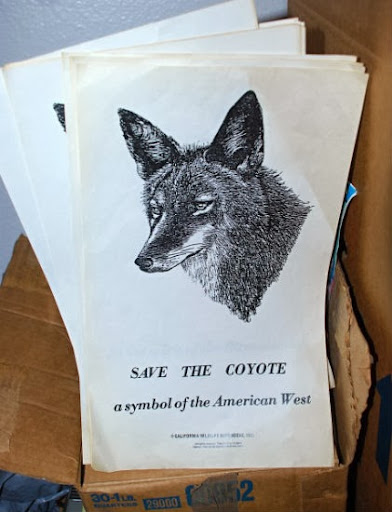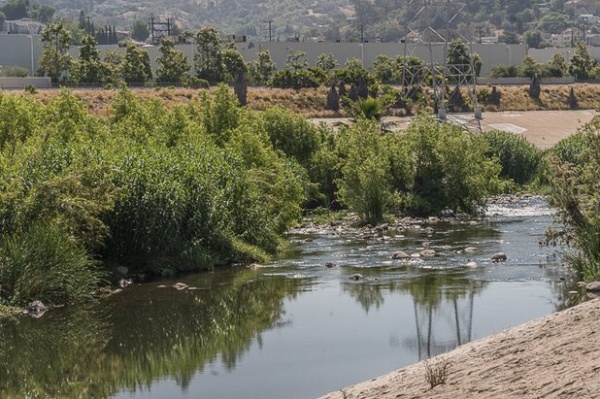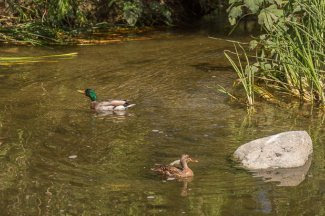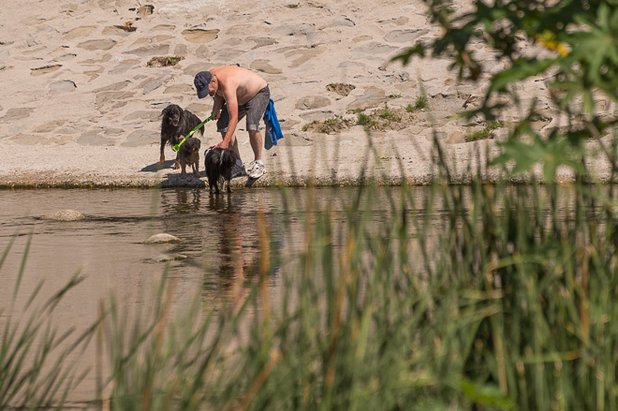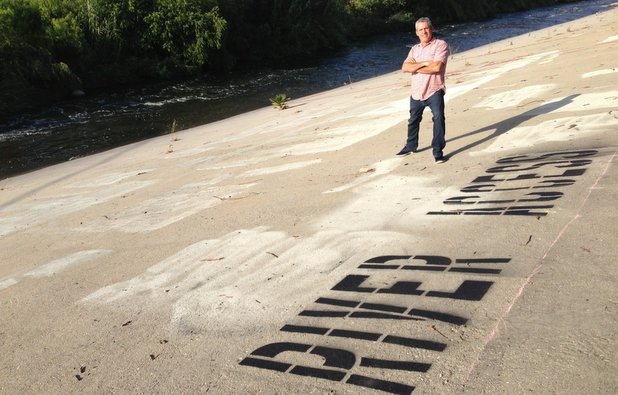Rangers will help manage river recreation area./Brenda Rees
Story By Brenda Rees Photos by Martha Benedict This weekend, the L.A. River will no longer be something to contemplate from only the shorelines, bike paths and freeway bridges.
In an experiment that could change Angeleno’s perception of the river, The L.A. River Pilot Recreation Zone officially kicks off on Memorial Day, Monday May 27, allowing the public to walk, watch birds, kayak and fish (with permits) on a 2.5 mile stretch of the Glendale Narrows waterway in Elysian Valley.
The summer-long program runs during daylight hours until Labor Day (September 2) and anyone can access the river free of charge for a Class I river rapids ride that will take about 2 ½ hours. (Note: organized groups will need a permit and that can take up to five days to secure.)
Only non-motorized, steerable boats – like kayaks and canoes – are permitted on the river. Sorry inner tubes and inflatable rafts, back to the pools with you.
Vendors offering guided excursions are hoping that Northeast Los Angeles gets bitten by kayak fever and sign up for an upcoming tour (most vendors will start their tour season on the weekend of June 1). Indeed, many challenges face individual kayakers who want a L.A. River experience:
- You’ll need two cars – one at the put-in location at Rattlesnake Park and one at Confluence Park near the take-out.
- There are only 40 parking spots at Rattlesnake Park that stretch from Ripple to Riverside off of Fletcher Avenue. You may have to portage your kayak across busy Fletcher.
- The trail from Fletcher is narrow and steep, especially when you are carrying a kayak.
- Kayakers must pull-out at Steelhead Park on Oros Street. You’ll have to walk up a steep trapezoidal slope, cross a bike path, pass through the small parklet and down a block to reach Oso Park.
- From there, you will leave kayaks to board a shuttle bus – which runs every 15 to 20 minutes – that will take you to the parking lot at Confluence Park (near the Home Depot parking lot on San Fernando Road). You will pick up your car and then drive back to Oso Park where you will load the kayak into your car in the five-minute loading zone.
- The river itself can be difficult. The flows are between Class I and II but water conditions can change overnight. You might have to walk kayaks over low flow areas. Other spots can be 6-feet deep. Even if you scout ahead – or study the river map – there are no guarantees the river will be flowing the same way the next day. Rain cancels all river activity.
With such a complex and exhausting process, river kayakers may consider signing up for a guided tour which should eliminate many obstacles. Just a heads-up: you may still have to do your share of portaging.
Ducks will have to share the L.A. River with people this summer./Martha Benedict
For two years, summertime kayaking on the L.A. River was offered at the Sepulveda Basin area and kayak organizers there seeing kayak opportunities in the Elysian Valley section of the river.
“The first year we had a few hundred people, but once people realized what we were doing, we sold out tours that second year,” says George Wolfe of L.A. River Expeditions. “Between our group and Paddle the L.A. River [another kayaking organization], we had close to 3,000 people kayaking on the river last summer.”
For Wolfe, exploring the Glendale Narrows section of the river will be a treat because of the moving water. “It’s going to be sportier and not just flat water,” he says describing most of the run at Sepulveda.
“This will have more rifts and rapids with more obstacles. It’s going to be a longer ride also. I think people are going to love this,” says Wolfe. “It’s going to be a lot of fun and a great way to spend a summer day.”
Wolfe’s experiences at Sepulveda Basin parallels the build-up to opening day, with community members worrying that the river program would bring in more traffic, trash and parking problems. “We did encounter a bit of NIMBY but we sought to find a way to make a solution to make everyone happy.”
The Mountain Recreation and Conservation Authority (MRCA) – the organization administering the Glendale Narrows pilot program in cooperation with city and county of Los Angeles, the Los Angeles County Flood Control District and the Army Corps of Engineers – has, in Wolfe’s opinion, been very “sensitive to the issues of safety and security [in Elysian Valley]. In the end, this program can only be a boon to the area.”
In addition to potentially more traffic in the area, Elysian Valley residents are dismayed that dog walking down by the river won’t be permitted in the recreation zone during the pilot program. “People will still be able to take their dogs alongside the bike path and into the parks,” says Fernando Gomez, chief ranger for the MRCA. “But we can’t have them bring the dogs into the water or five feet of it.”
Gomez says that the MRCA will be monitoring the recreation zone from sunup to sundown daily once it is opened to the public. One MRCA ranger as well as up to a dozen MRCA volunteers will be on patrol duty either on foot, bike or boat. “The LAPD will have the initial authority and city police will respond to any calls, but we will also be on hand to assist if necessary,” he says.
Oso Park sculpture./Martha Benedict
The extra security should be welcomed in the neighborhood where recently a biker was attacked on the bike path.
Still, the question remains: Will Anyone Kayak the River?
“Everyone that I know is excited about it,” says Steven Appleton, president of the Elysian Valley Riverside Neighborhood Council who, along with being a professional artist, will soon be adding kayak guide to his resume.
Appleton, along with fellow Elysian Valleyite Grove Pashley, will be leading L.A. River Safari kayak tours, an operation that will give Appleton a chance to introduce people to the history, nature and community of his neighborhood. “There are some places in the river you really have no idea you are near downtown L.A. Herons, egrets, carp jumping up. It’s mind-boggling.”
Appleton intends on employing and training local youth to help with the operation. In addition, he plans on reaching out to community and youth groups, offering them river trips at reduced rates. (Both L.A. River Expeditions and L.A. River Safari trips will run about $60-$70 per person.)
Both vendors will employ a novel way for kayakers to return to their parked cars at Rattlesnake Park. Once they are back on land at Confluence Park, participants will jump on bicycles and cruise the river route from a different perspective.
All in all, opening day of the recreation zone will write a new chapter in the continuing saga of the L.A. River.
Like many, Appleton is an optimist that a river experience can be radically energizing.
“I think once we bring people to the river and show them what it is, they will fall in love with it,” he says. “It really can be a river for all of us.”
Click here for more information about the L.A. River Pilot Recreation Zone.
Sorry, no dogs will be allowed in the river. Dogs will be allowed on path at the top of the river channel./Martha Benedict
Bird watchers will have plenty to look at along the river./Martha Benedict
Kayakers will have to navigate around some urban obstacles./Martha Benedict
L.A. River path runs along the Elysian Valley side of the waterway./Martha Benedict
Steve Appleton at the River Access point on L.A. River Recreation Zone./Miguel Luna
Brenda Rees is a writer and resident of Eagle Rock. Martha Benedict is a photographer and resident of Montecito Heights







